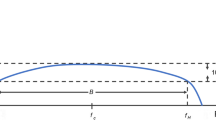Abstract
This paper presents the signal time dispersion in an indoor radiating cable system by using wide-band propagation measurements. The indoor environment was a university building, and the measurements were carried out in the first, second and third levels using a vector network analyzer with a frequency range of 1.25–1.75 GHz. Two cases were studied. The results show that despite both cases having the same environment and installation, the different connections of the feeding point generate dissimilar conditions of the channel, e.g., the channel is most affected by signal delays in one case. The analysis of rms delay spread includes local and global distributions, spatial correlations, and scatter diagrams with the mean excess delay and path loss. Most of the time, the results indicate a higher concentration of power at the middle delay path, and the relationship between the rms delay spread and path loss depends mainly on the delay spread generated by the cable installation. It was found that the rms delay spread increases when the mobile antenna is near to the feeding point of the cable. Furthermore, little adjustments to the cable installation were also made and their effects on the channel are presented. Therefore, the radiating cable can provide an almost uniform coverage; however, the planning and installation of indoor radiating cable systems for high transmission rate must be carefully developed. These results allow us to understand the channel behavior for better planning and designing of radiating cable applications in indoor environments.



















Similar content being viewed by others
References
Heath, R., Peters, S., Wang, Y., & Zhang, J. (2013). A currents perspective on distributed antenna systems for the downlink of cellular systems. IEEE Communications Magazine, 51, 161–167.
Jevremovic, V. (2015). High-density wireless networks for public venues: Challenges and best practices. White paper http://www.ibwave.com/pdf/white_paper/Public_Venue_Networks_Jan_26_2015.pdf. Accessed 26 April 2016.
ProSoft Technology, Radiating Cable Installation Guide. http://www.prosoft-technology.com/content/download/8973/168782/version/1/file/Radiating+Cable+Installation+Guide.pdf. Accessed 15 January 2016.
Chuang, J. C. I. (1987). The effects of time delay spread on portable radio communications channels with digital modulation. IEEE Journal on Selected Areas in Communications, 5(5), 879–899.
Pahlavan, K., & Levesque, A. H. (2005). Wireless information networks (2nd ed.). New York: Wiley.
Medbo, J., & Nilsson, A. (2012). Leaky coaxial cable MIMO performance in an indoor office environment. In Proceeding of 23rd international symposium on personal, indoor and mobile radio communication (pp. 2061–2066).
Jamaly, N., Merz, R., Schumacher, A., Scanferla, D., & Wenger, D. (2016). MIMO capacity enhancement beyond that of ideal rayleigh multipath by virtue of a leaky feeder cable. In Proceedings of 10th European conference on antennas and propagation (pp. 1–5).
Hou, Y., Tsukamoto, S., Maeda, T., Ariyoshi, M., Kobayashi, K., & Kumagai, T., et al. (2015). Realization of 4-by-4 MIMO channel using one composite leaky coaxial cable. In Proceedings of 12th annual IEEE consumer communications and networking conference (pp. 103–108).
Electronic Communications Committee ECC Decision (13)03: The harmonised use of the frequency band 1452–1492 MHz for mobile/fixed communications networks supplemental downlink (MFCN SDL), http://www.erodocdb.dk/docs/doc98/official/pdf/eccdec1303.pdf. Accessed 11 April 2016.
Sánchez, M., & García, M. (2001). RMS delay and coherence bandwidth measurements in indoor radio channels in the UHF band. IEEE Transactions on Vehicular Technology, 50(2), 515–525.
Hashemi, H., & Tholl, D. (1994). Statistical modeling and simulation of the RMS delay spread of indoor radio propagation channels. IEEE Transactions on Vehicular Technology, 43(1), 110–120.
Feuerstein, M. J., Blackard, K. L., Rappaport, T. S., Seidel, S. Y., & Xia, H. H. (1994). Path loss, delay spread, and outage models as function of antenna height for microcellular system design. IEEE Transactions on Vehicular Technology, 43(3), 487–497.
Acknowledgements
One of the authors, Jorge A. Seseña-Osorio wishes to thank the Mexican Consejo Nacional de Ciencia y Tecnología for the postdoctoral fellowship (CVU Number 207016).
Author information
Authors and Affiliations
Corresponding author
Ethics declarations
Conflict of interest
The authors declare that they have no conflict of interest.
Rights and permissions
About this article
Cite this article
Seseña-Osorio, J.A., Aragón-Zavala, A. & Castañon-Ávila, G.A. Experimental Study of the Delay Spread in an Indoor Radiating Cable System. Wireless Pers Commun 98, 897–927 (2018). https://doi.org/10.1007/s11277-017-4901-0
Published:
Issue Date:
DOI: https://doi.org/10.1007/s11277-017-4901-0




